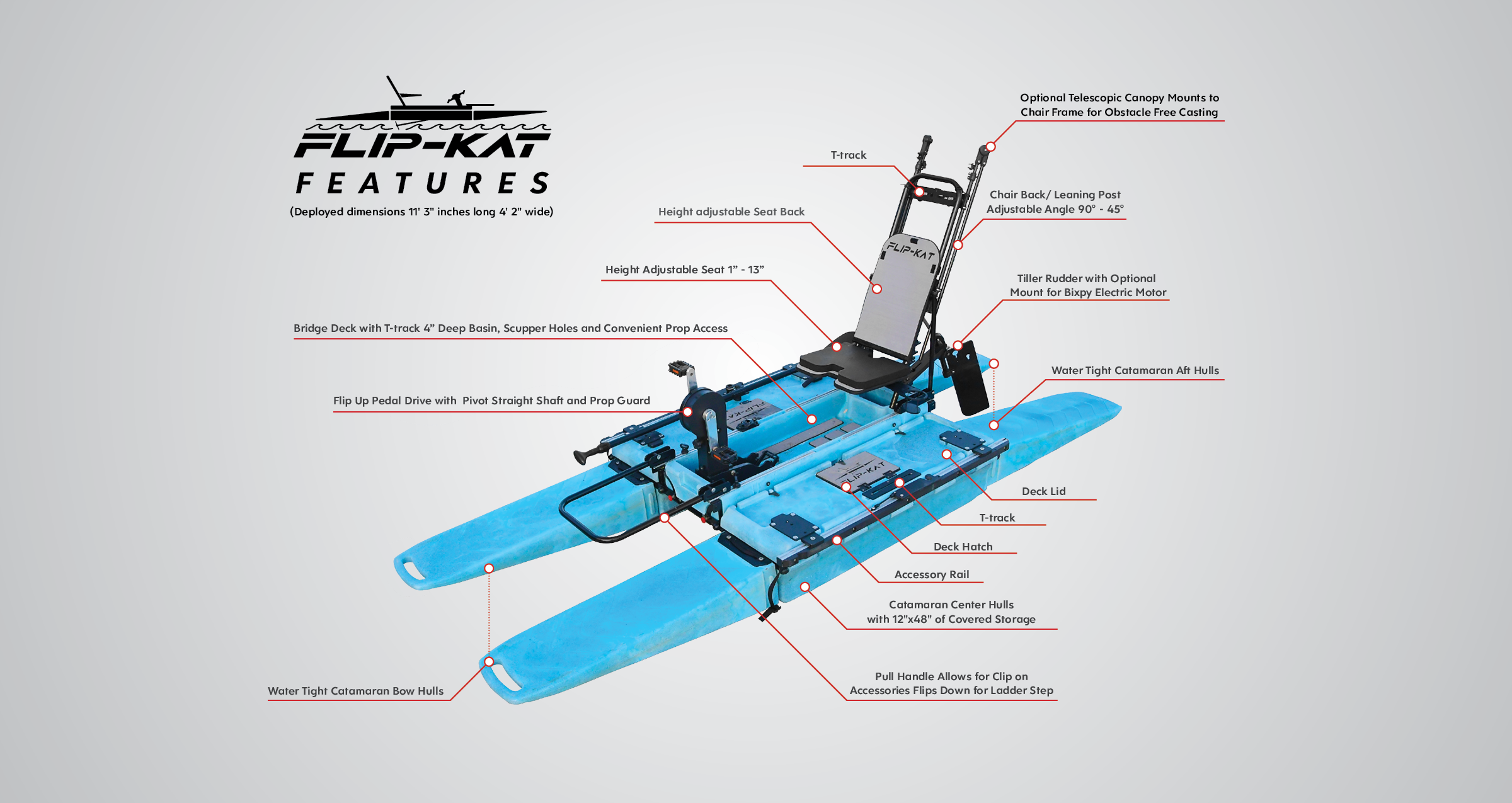Comprehensive Kayak Maintenance and Repair Guide
17th Apr 2025
Table of Contents:
Introduction to Kayak Maintenance
As with any water vessel, routine maintenance and repairs are the best practices for extending the longevity of your craft. Whether you’re just removing dirt/debris or patching a hole, maintenance and repairs will improve the quality of your kayak experience on the water and its longevity. Maintaining a kayak is not a difficult task, especially if you create a regular routine for cleaning. Here are some tips/tricks for maintaining and repairing your kayak whether you have an old, passed down kayak or a new, fancy Flip-Kat®.
Routine Maintenance Essentials
Routine kayak maintenance is an easy task to stay on top of. Your basic maintenance will consist of simple cleanings and inspections to keep everything in tip top condition. These practices will improve your enjoyment on the water and the life on your kayak:
Cleaning Basics for All Kayaks
A basic cleaning can do wonders for a kayak. This process doesn’t have to be intensive; we recommend giving your kayak a quick spray down with a hose after each time on the water, especially if you’re kayaking in a dirty lake or salt water. This spraying doesn’t have to be a deep cleaning, but still pay attention to cover all areas of your kayak both inside and out. Areas like the rim of the cockpit, inside hatches, and down around the foot holds are spots where gunk tends to accumulate and deserve slightly more attention because of it.
Inspecting for Damage
Inspecting for damages is another simple process to add to your maintenance schedule. Especially while cleaning, pay attention and notice any damages to problem areas. Especially after a rough day on the water/maybe a collision, adding a hull check to your inspections is a must to be sure everything is still up to the water standards. Besides potential hull damages from a collision, here are some of the other major areas where wear and tear can accumulate:
Areas Prone to Wear and Tear
- Handles
- Bulkhead
- Mounts/mounting tracks
- Rudder/skeg
- Foot pedals
- Fish finder/other electronics
@noisyriveroutdoors It’s time to forget about attaching and detaching pedals!
Minor Repairs
Inevitably, damages will occur and repairs will be needed. This can be simple like replacing handles that have degraded or swapping out old mounts. For hull scratches and leaks that are a bit more resolved, one can utilize a kayak repair kit.
Repairing Scratches and Small Leaks
Whether you hit a rock, a branch, or another kayak, scratches and small leaks are bound to appear in a hull. This is not the end of your kayak. There is quite a variety of different kayak repair kits readily available for purchase online. Depending on the scale of the damages, you can opt for a special tape approach for larger damages or use marine epoxy to plug a smaller hole.
Flip-Kat Specific Care and Maintenance
Flip-Kat® kayaks aren’t exempt from care and maintenance. In fact, the unique features that make the Flip-Kat® so successful on the water do require minor maintenance to keep them working in top condition. Here are some of the best practices for kayak maintenance specifically for the unique features of a Flip-Kat®!
Unique Flip-Kat® Features to Maintain
What really makes the Flip-Kat® stand out from the competition is the hinges that allow for a foldable design alongside the unique mounts and pedal propulsion system. These areas, while requiring specific attention, don’t require any special techniques to have working smoothly.
Caring for the Foldable Design
Keeping the hinges in good condition is vital for the folding design of the Flip-Kat®. Maintenance is simple, though, as you just need to spray off the hinges and allow them to dry for the best results. Especially if you’re paddling in salt water, rinsing your hinges can dramatically increase the longevity of your Flip-Kat®.
Handling Specialized Parts
The Flip-Kat® also comes with some specialized parts including the pedal propulsion system. These areas are also easy to maintain with routine hose rinsing. Taking special care to not damage these specialized parts in transportation or use is another big part of extending your Flip-Kat®’s longevity. Especially if pieces are hanging below, be sure to transport with care.
Flip-Kat® Cleaning and Protection Tips
For the most part, cleaning your Flip-Kat® is largely like any other kayak with a few extra areas to clean like the hinges. Thus, keeping your Flip-Kat® in top condition is a very manageable task!
Recommended Cleaning Products
For cleaning your Flip-Kat®, a hose will be your best friend. A light soap can help, but isn’t necessary for getting dirt/debris off the shell and out of the hinges. Kayak wax can be applied, but isn’t necessary, for slightly easier gliding through the water and extra sheen on the body of the kayak.
Lubricating and Protecting Hinges
A huge feature for the Flip-Kat® kayak is its ability to fold and easily store. The hinges on the kayak do a lot of that lifting, so keeping these hinges in working order is a large priority. To protect your hinges, partake in regular rinsing and drying to avoid the formation of any crust inside. From there, the occasional lubrication of your hinges will keep your Flip-Kat® transitioning seamlessly between folded and unfolded/ready to use. Always be careful during transportation to avoid any unnecessary damages.
Seasonal Tips for Storage and Maintenance
Inevitably, the winter brings colder weather and largely forces us off the kayaks. In these instances, storing your kayak for winter is generally the best practice. Here is the best way to store your kayak over winter as well as get it ready for the water again in the spring:
Preparing for Winter
Preparing your kayak for winter starts with a round of cleaning. Rinsing your kayak off before the long store is a great practice to employ. Fill any cracks/scratches, as water can get in these areas, freeze, expand that makes the problem worse. From there, you need a place to store your kayak. If you have garage space/other inside space where you can store a kayak, this is a great place. A roof will keep the elements off your kayak preventing any additional wear and tear.
If you can’t store inside, a kayak can do just fine outside for a winter. For storing outside, you want to find a covered area, whether that is under the cover of a tree or close by a building where an overhang can protect it. Especially if you’re storing outside, but even inside, flip your kayak upside down to prevent rain/snow/other falling things from filling the cockpit.
Spring Readiness Check for Flip-Kat®
Come springtime and the reemergence of your kayak, it’s best practice to perform a quick readiness check for your Flip-Kat® to make sure everything is in working order prior to getting on the water. This process is as simple as unfolding your Flip-Kat® in the spring, rinsing away any dirt/cobwebs that have accumulated, and inspecting for damages/inconsistencies in the hinges and hull. Once a quick check is done with everything in working order, your Flip-Kat® is once again ready to taste the water!
Conclusion - Keep Your Kayak in Tip Top Shape
Flip-Kat® maintenance is not any sort of super involved task that still has a dramatic improvement on the functionality and durability of your kayak. Gentle rinsings after use, the occasional hinge lubrication, and proper winter storage are the pillars of great kayak maintenance. The key is to find a routine that is easy for you to maintain to ensure your Flip-Kat® gets the attention it deserves. Through these practices, you can enjoy your Flip-Kat® kayak for years and years to come!








